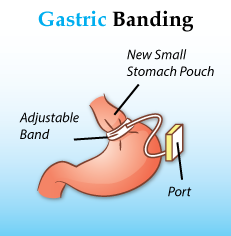LAP-Band Surgery
-
Content written by Andrew Proulx, MD | Reviewed by EnhanceMyself Medical Team | Last updated 6/12/2023
- Overview
Overview
What is Lap-Band surgery?
Lap-Band surgery, also referred to as laparoscopic adjustable gastric banding or simply gastric banding, is a minimally invasive approach to weight loss. During this procedure, a thin and adjustable silicone band is positioned around the upper part of the stomach. Its purpose is to restrict the amount of food a person can consume. Once the band is in place, it slows down the passage of food from the upper stomach to the lower part, resulting in patients feeling full more quickly. The Lap-Band method aids people in shedding excess pounds by encouraging them to eat smaller portions over time.
Cost of Lap-Band
The average cost for Lap-Band surgery ranges from $10,000 to $30,000. There are several factors that can influence the overall cost, such as:
- Your Surgeon: The experience, qualifications, and reputation of your Lap-Band surgeon can make a difference. Highly skilled bariatric surgeons may charge higher fees for their services.
- Location Matters: The location of your bariatric clinic can make a difference. The cost of living, overhead expenses, and market competition in a particular country or city can influence pricing.
- Anesthesia: This fee relates to the type of anesthesia used, the duration of your procedure, and the qualifications of the anesthesiologist.
- Hospital Fees: Fees usually charged by the hospital or surgical facility for the use of their operating room, equipment, and staff.
- Pre & Post-Operative Care: Pre-operative evaluations, lab tests, and medical assessments are typically required before surgery. After surgery, post-operative care including follow-up visits, support groups, and adjustments to the lap band.
- Insurance: Insurance can have a major impact the cost of surgery. Some insurance plans may cover a portion or all of the procedure if specific criteria are met. Contact your insurance provider directly to understand your coverage and any out-of-pocket expenses.
Are you a candidate?
Lap-Band surgery is typically recommended for individuals who meet certain criteria and have been unsuccessful with non-surgical weight loss methods. Here are some general factors that may make you a good candidate for the procedure:
- Body Mass Index (BMI): Candidates often have a BMI of 40 or higher, or a BMI of 35-39.9 with obesity-related health conditions such as diabetes, high blood pressure, or sleep apnea. BMI is a measure of body fat based on height and weight.
- Commitment to Lifestyle Changes: Lap-Band surgery requires a commitment to lifelong lifestyle changes, including dietary modifications, regular exercise, and behavioral changes.
- Failed Attempts at Non-Surgical Weight Loss: Candidates have typically tried and failed to achieve significant weight loss through non-surgical methods such as dieting, exercise, and behavioral therapy.
- Age and Health Status: Surgery is generally recommended for individuals between the ages of 18 and 60, although this can vary depending on the specific circumstances. Candidates should be in generally good health, without significant medical conditions that could increase the risks associated with surgery.
- Psychological Evaluation: A psychological evaluation is often conducted to assess a candidate’s mental and emotional readiness for the procedure. Candidates should have realistic expectations, understand the risks and benefits, and have adequate support systems in place.
- Motivation and Willingness to Follow Guidelines: Successful Lap-Band surgery outcomes depend on the patient’s motivation and willingness to follow post-operative guidelines. Candidates should be committed to attending regular follow-up appointments, making necessary dietary changes, and adhering to the recommended exercise and lifestyle modifications..
Individuals interested in Lap-Band surgery should set up a consultation with a qualified bariatric surgeon to discuss their specific circumstances and determine if they are a good candidate for the procedure.
Procedure overview
Lap-Band surgery is performed under full anesthesia and it takes one to two hours to complete.
During the procedure, a surgeon makes a small incision and then inserts a thin tube with a light and camera on the end of it that is called a laparoscope. This tool is used to properly position the band.
The adjustable band is similar to a wristwatch, and it’s fastened around the upper region of the stomach to create a tiny pouch that controls the amount of food a person eats. It contains sterile salt water that allows a doctor to inflate or deflate the band by changing the amount of salt water inside of it.
The band is also connected to a tube with an access port at the end of it. The port is placed directly below the skin during the surgery and thin needle can be inserted into the port to adjust the size of the band by either adding or removing fluid from it.
A surgeon can adjust the band as needed to regulate the rate of weight loss.
Benefits of Lap-band procedure
Lap-Band surgery offers several potential benefits for individuals struggling with obesity and related health conditions. While the specific outcomes may vary from person to person, here are some potential benefits associated with Lap-Band compared to other weight loss procedures:
- Does not require stapling, cutting, or redirection of the stomach or intestines
- The least invasive form of gastric surgery for weight loss
- Low incidence of serious pain and complications after surgery
- Shorter recovery times and hospital stays
- Band adjustments can be performed without having to undergo additional surgery
- Lowers the risk of nutritional deficiencies that are linked to a gastric bypass
- Helps sustain weight loss for long periods of time
- Improves insulin resistance, type 2 diabetes, and pancreatic function
- Safe enough to use during pregnancy
- Cost less than other types of gastric surgeries
- The band can be removed at any time
- The stomach typically returns to its original form if the band is removed
- Improves obstructive sleep apnea, gastroesophageal reflux, and depression
Recovery time
The hospital stay following the procedure is typically 1 to 2 days, and individuals can usually return to work after one week. Most patients fully recover by the end of the second week.
The first follow-up appointment is usually scheduled two weeks after the surgery. The first assessment to determine whether the band needs to be adjusted is conducted around week six.
What type of results to expect
In general, lap band surgery typically results in a weight loss of 40% to 60% of excess body weight over a period of 2 to 3 years.
The weight loss goal is 0.5 to 1 pound per week and the band is adjusted based on an individual’s weight loss needs. Additional adjustment reassessments are performed every six weeks until the sixth month, and then the appointments are scheduled every three to six months.
How long does the Lap-Band last?
Gastric bands deteriorate over time and eventually need to be removed or replaced. Studies show that 35% to 40% of people may have their gastric bands removed after 10 years. There are several reasons why the band may be removed, including inadequate weight loss, erosion, or obstruction.
Alternatives to Lap-band
Gastric Bypass: Before the introduction of Lap-Band surgery, gastric bypass surgery was the most common type of bariatric surgery, which refers to an operation that leads to weight loss by altering the digestive system. A gastric bypass entails using staples to divide the stomach into two parts, a small upper section called a pouch and a large lower section. The small pouch is connected to the small intestine in order to completely bypass the larger portion of the stomach. The pouch allows individuals to feel full after eating smaller amounts of food, and this leads to weight loss.
Sleeve Gastrectomy: Another effective weight loss procedure is sleeve gastrectomy. This type of surgery involves removing a portion of the stomach and forming the remaining section into a sleeve. This reduces the stomach’s size and limits the amount of food a person can consume. As a result, the person begins to feel full after eating small meals and this usually leads to about 80% loss of excess weight over a period of two years.
To learn more about gastric banding, visit the MedlinePlus website.
EnhanceMyself.com relies on sources such as professional medical organizations, government agencies, academic institutions, and peer-reviewed scientific journals to write it’s articles. Learn more about how we ensure our content is accurate, in-depth, and unbiased by reading our editorial guidelines.
*Medical Disclaimer: This website does not provide medical advice. Read more.


